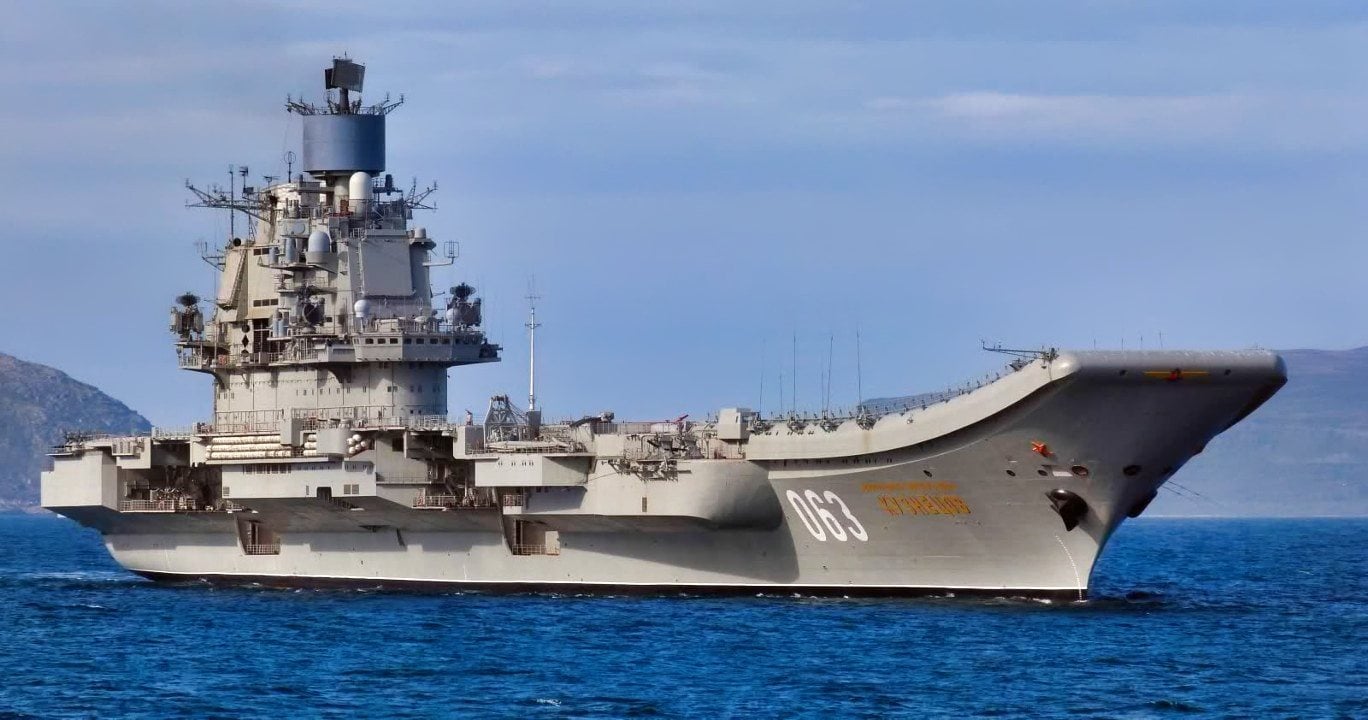Russia's Admiral Kuznetsov Aircraft Carrier Has a 'Black Smoke' Problem
Russia’s aging aircraft carrier, Admiral Kuznetsov, is infamous for its thick, black smoke emissions due to its reliance on Mazut, a tar-like heavy fuel oil.
Summary and Key Points You Need to Know: Russia’s aging aircraft carrier, Admiral Kuznetsov, is infamous for its thick, black smoke emissions due to its reliance on Mazut, a tar-like heavy fuel oil.
-This archaic propulsion system causes environmental damage and limits the carrier's operational capabilities.
-Designed in the late Soviet era as a proof of concept, the carrier was never fully developed into a larger program due to the USSR's collapse.
-Despite its environmental and logistical shortcomings, Russia continues to maintain Kuznetsov, symbolizing Moscow’s questionable commitment to naval power, though it may be more strategically sound for Russia to focus on submarines and smaller warships.
Admiral Kuznetsov’s Aging Engines: Russia’s Struggle to Modernize Its Last Aircraft Carrier
Belching thick black smoke into the cerulean blue skies as it traverses the world’s oceans, the Russian aircraft carrier Admiral Kuznetsov leaves a black Sharpie-like line for all its potential adversaries to see. It’s a unique sight on the world’s oceans because most warships today do not spew such filth visible to the naked eye as the boat navigates throughout the world.
But the Admiral Kuznetsov is a rare and unique boat. Not in the valuable way, but in the sunk cost way.
An aging, decrepit carrier held over from the final days of the Soviet Union, the Kuznetsov billows its pollution into the skies above because of its archaic propulsion system. Kuznetsov is powered by Mazut, a tar-like fuel that is a byproduct of the oil refining process and is commonly used in industrial and commercial applications such as heating and power generation.
Mazut is also known as heavy fuel oil or bunker fuel, and it is typically used in large ships and power plants.
Understanding Mazut
Mazut has a high sulfur content and is, again, known for its thick, black smoky emissions. When burned, mazut releases a number of harmful pollutants into the air, including sulfur dioxide, nitrogen oxides, and particulate matter. These pollutants can have a significant impact on air quality and can contribute to a range of health problems, including respiratory illnesses, heart disease, and cancer.
In addition to its impact on air quality, mazut can have a negative effect on water quality. When spilled or leaked into bodies of water, which the Admiral Kuznetsov routinely and notoriously does with wanton abandon, mazut can form an oil slick that can harm aquatic life and damage the surrounding ecosystem.
Thus, Russia’s war both on its neighbors and on the environment continues unabated in the twenty-first century.
The use of mazut fuel on the Admiral Kuznetsov has been a source of controversy, as it contributes to the ship’s poor environmental performance. Indeed, mazut, unlike other sources of fuel that power warships, is a highly limiting factor in the operational abilities of the dying Russian flattop, despite that it is a relatively abundant and cheap fuel source.
The decision to use mazut fuel on the Admiral Kuznetsov is likely due to multiple factors, though. Yes, it is abundant in Russia and cheap. But another possible reason is that the use of mazut was an attempt by the old boat’s Soviet engineers to simplify the aircraft carrier’s propulsion system.
Gas turbine engines are typically designed to run on lighter, cleaner fuels, but the use of mazut may have been seen as a way to reduce the warship’s complexity (and, therefore, to cheapen its construction and maintenance).
What the Admiral Kuznetsov Is & Is Not
When the Soviets designed the Admiral Kuznetsov, they did it more as a proof of concept and less as the beginning of a new trend in the Soviet Navy. Had the flattop been successful (more importantly, had the USSR not collapsed when it did), the Admiral K would have been used as the basis for springboarding the Soviet Red Navy into massive aircraft carrier operations to challenge the U.S. Navy.
Since the USSR did unexpectedly collapse and the Russians entered a dark decade of despair in the aftermath (that Russia is only now climbing out of), Moscow has been forced to remain committed to a clearly dilapidated warship.

Admiral Kuznetsov: The Aircraft Carrier Tragedy for Russia That Won't End
When—and if—the Russians really do enhance their carrier capabilities, one can anticipate that the next batch of Russian carriers will be far more complex and reliable than the current Admiral Kuznetsov.
At the same time, though, Russia has never been (and likely never will be) a maritime power. With that in mind, it might be a better move for the Russians to prioritize their ground, space, and air forces over their navy.
They might want to simply focus on building submarines and smaller surface warships, as the Russians are better at that than they are at wasteful carrier operations.
However, Moscow’s decision to blow so much money on keeping the dying Admiral Kuznetsov sailing indicates Moscow’s frankly bizarre commitment to the Admiral K that defies strategic logic and reason.
About the Author:
Brandon J. Weichert, a National Interest national security analyst, is a former Congressional staffer and geopolitical analyst who is a contributor at The Washington Times, the Asia Times, and The-Pipeline. He is the author of Winning Space: How America Remains a Superpower, Biohacked: China’s Race to Control Life, and The Shadow War: Iran’s Quest for Supremacy. His next book, A Disaster of Our Own Making: How the West Lost Ukraine, is due October 22 from Encounter Books. Weichert can be followed via Twitter @WeTheBrandon.
All images are Creative Commons and/or Shutterstock.


